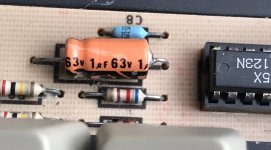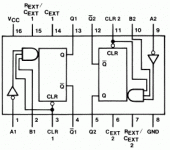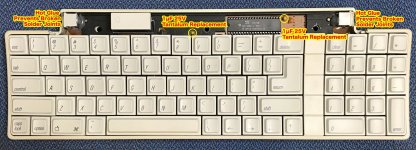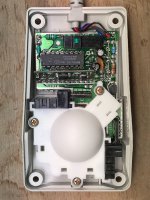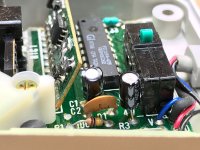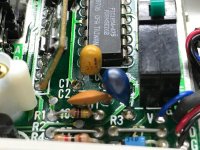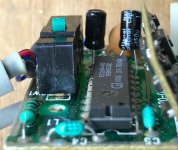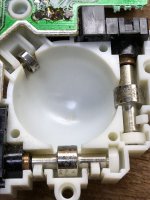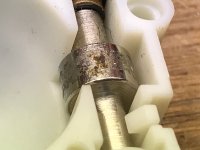28 views of this thread as of the time of this writing but no replies, and here I am back to talking to myself again. :-(
According to the
Operating Rules on page 3 of this
74LS123 data sheet, the 1uF capacitor in combination with the 200k-ohm resistor forms a timing circuit that determines pulse width. Since the 1uF capacitor sits behind a 200k resistor tied to 5V, it's not clear why Apple's 1uF capacitor is rated at 63V. Certainly, the capacitor would have been cheaper had they used a lower voltage rating. And even though the positive side of that 1uF capacitor is also tied to the Rext/Cext pin of the 74LS123 chip, it's not possible that pin will see anywhere close to 63 volts.
Why then did Apple choose a 1uF capacitor rated at 63V? Well, we know that the higher the voltage rating of an electrolytic capacitor the lower the ESR, and since 1uF electrolytic capacitors have a large ESR even when brand new, choosing 63V (probably the highest voltage available back in 1983) would have yielded the lowest ESR. But that is just my speculation. And why Apple would have wanted lower ESR is not clear because the 74LS123 data sheet makes no mention of capacitor ESR, and I have checked several 74LS123 data sheets even as far back as 1983. So I don't really know what to think if that voltage rating choice is NOT tied to ESR.
So the question remains, what capacitor should we use as a replacement?
Since that aforementioned datasheet says Tantalum capacitors can be used, it is a matter of choosing the voltage rating. The Vishay
173D105X9050VWE3 is a perfect length and diameter axial tantalum capacitor rated for 50V but can handle a surge voltage of 65V. It currently costs $1.17 at Mouser, which is fairly high but much lower than the $3.23 100V 1uF electrolytic I mentioned in my opening post. And because this $1.17 cap is Tantalum and rated at a fairly high voltage, the ESR would be less than the 63V electrolytic Apple uses, but yet not super-low like a ceramic capacitor would be. But again, I don't think the rated voltage matters in terms of voltage surges, because I doubt we'd even get double Vcc (10V) across that capacitor. So I would assume that an even lower voltage rated tantalum axial capacitor would suffice. However, going down to a 35V tantalum axial capacitor only drops the price to $1.06. And going to a 25V part only drops the price to $0.97. So we might as well choose the 50V rated Vishay tantalum I linked to.
Why choose a tantalum rather than an electrolytic? Because we don't want to swap out an electrolytic replacement again 20 years hence. Even the best electrolytic caps will eventually dry out and/or leak. A tantalum capacitor will last the life of the keyboard.
So I think I will go with the 50V Vishay cap, unless some of you present good reasons to avoid it. Feel free to share you thoughts. No, actually,
please share your thoughts. I feel lonely talking to myself in this forum.
Thanks.
